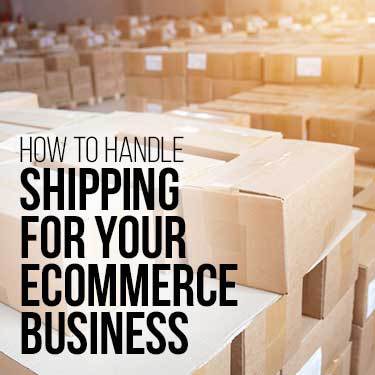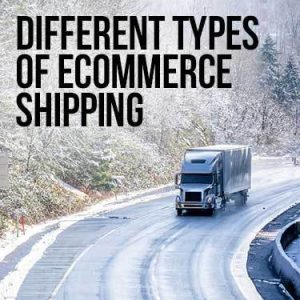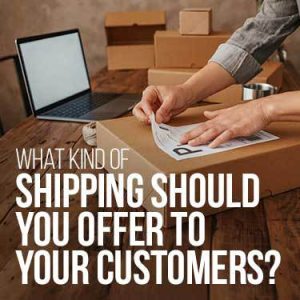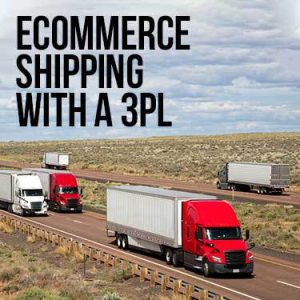
 Copy URL to Clipboard
Copy URL to Clipboard
You’ve got a great product or stable of goods to sell, a business model that should stand on its own and the desire to work hard and make money. However, you’re running an online enterprise and still need to figure out an aspect that could make or break your ability to be successful: how to handle your ecommerce shipping. This can be a giant pain point for customers and businesses alike, so getting it absolutely right should be a fundamental focus.
Ecommerce shipping is a process that involves many details and critical decisions. The process includes whether to offer free shipping to customers, how to package products, warehouse considerations, and more. Many ecommerce companies rely on a Third Party Logistics (3PL) provider to manage shipping and order fulfillment.
Below, we outline the steps you need to take in order to setup and manage shipping for your ecommerce business.
Table of Contents

Before you decide what you can afford or what would work best for your ecommerce business model, it’s imperative to hone in exactly what your opinions are for shipping. The biggest differences between the following kinds are how much of it you do directly or outsource to another company. Each has their own positives and negatives and you’ll be tasked with weighing each carefully to determine which will make your enterprise flourish. Not to put undue pressure on you, but it is very important you figure out which will work best for you because it can definitely have a major impact on your business, for better or worse.
Good old D.I.Y. is definitely an option. This is just as it sounds, but even this comes in some different varieties. For instance, if your sales are small enough, you might be working out of your house, garage or perhaps a modest office/facility. Things might be low key and manageable enough to fill the orders yourself or with a team of people. In this setup, it could be easy enough to simply fill the orders as they come in over the internet.
This is good if you can handle doing so without compromising your abilities in other areas. You get to keep whatever profits roll in and it is a self-contained supply chain without middle men or any additional step that could complicate the procedure.
However, the drawback could come from your operation being small enough that filling each order yourself is more costly since you don’t have the advantage of lower bulk shipping that a larger enterprise or even one — as an example — who is connected to a third-party logistics company that has access to lower shipping prices because of the connections they possess. Also, just packaging and shipping a small amount of orders can be a time-consuming process that doesn’t allow you to focus on issues within your business that could really use attention.
Another potential drawback is if you need to expand your operations. If you plan on doing everything yourself, that means you’re on the hook for buying or leasing upgraded facilities to accommodate the increased workload and space needed, plus possibly adding additional workers of your own.
Warehouse fulfillment is currently at an all-time high and shows no signs of slowing down. So if you have an enterprise that you want to thrive in the current economic climate, using a 3PL to fill and ship your orders can be a huge advantage to your bottom line.
Outsourcing order fulfillment to a third-party logistics (3PL) company is an option when you don’t have the storage of a warehouse or the necessary setup to ship on the scale needed. But it can also be beneficial to any ecommerce business that would just prefer the fulfillment of their orders, which includes shipping, done on their behalf.
The benefits to using a 3PL for order fulfillment are numerous and used by many. The first one is that you don’t have to acquire space or make a huge upfront investment to get your shipping set up. You can access a 3PL’s already established infrastructure for your burgeoning business without having to invest a large amount of resources.
Instead, you pay for what warehousing space you need and pay per order/item fulfilled to customers on your behalf. Space in a warehouse is reasonably inexpensive and even the fulfillment cost itself might surprise you since 3PLs deal in such large overall volume that they can access discounted pricing on shipping and packaging materials that a smaller outfit couldn’t.
Another benefit is having less on your plate. Maybe you don’t want to or cannot give the time or energy to meticulously overseeing or filling each order as it comes in. So you can lean on another company that has the wherewithal, experience and resources to easily undergo this task for you. You can be more concerned with the bigger pictures of procuring your products or balancing the books than the minute-to-minute aspect of shipping.
On demand warehousing is directly linked to order fulfillment. Except in this scenario, it’s not necessary to exclusively use a 3PL and the structure of how you pay for both the warehousing and actual order fulfillment for your ecommerce shipping can slightly differ. It starts with you as the ecommerce business finding a company that has available warehousing space to store your goods.
Usually, that company will offer additional services which can include order fulfillment and shipping. Where this diverges somewhat from 3PL order fulfillment is it might not be a 3PL company that you’re paired with and you will be charged only for the space and services that are used. This can have big advantages for your business, especially if your operations are affected seasonally or just have any kind of variation in the services you actually require from day to day or month to month.
Instead of having to sign a contract for a certain amount of warehouse space, order fulfillments or shipping each month or year, you are literally charged for what the company provides for you. If one month, you need to store 15 pallets and fill 1,000 orders but the next month, it’s 10 pallets and 750 orders, that’s no problem. You will not be charged the same overall rate and it can result in savings for you.
The only real downside to this setup is because things are much more fluid in such a scenario, if you had a huge spike in the amount of goods you need stored or shipped out and there’s not the longer-term commitment locking in a certain amount of space, the company may be unable to accommodate you.
Having trouble kepping track of multiple sales channels? Check out our article on Omnichannel Order management to find out how to get help.

Besides figuring out how you’re going to have your items shipped to customers, it’s also a good time to figure out exactly how you plan on enticing said consumers to want to buy your products. Again, the answer could be shipping. The variety of shipping options offered could be the difference between a sale or goods sitting on a shelf.
This topic could be its own article, because if you’re able to offer free shipping to your customers, it can be the final push they need to make that purchase. So, the short answer in this regard is you should definitely endeavor to make shipping free for your customers. But let’s further outline the situations where it would be advantageous or not to offer this.
First of all, the biggest thing you have to determine is if you can remain profitable while making free shipping available. If you cannot turn an overall profit, then it’s just not sustainable or worth it to you. Because while shipping might be “free” for your shoppers, your shipping costs aren’t going anywhere.
Free shipping can offer a big boost, though, especially as an incentive to either keep pace with competitors or even possibly best those who cannot offer free shipping. Free shipping is proven to cause customers to buy more or even buy when they are on the fence or even otherwise wouldn’t.
Even if you’ve made the decision to move forward with this approach, you still need to know how to offer free shipping. There isn’t a one size fits all approach when it comes to offering free shipping, so it’s helpful to understand the various options available. An example would be if you planned on offering 40 percent off everything you’re selling, but you can’t swing offering free shipping if you do that. This is an example where maybe 25 or 30 percent off your products plus free shipping will be more enticing to a customer sitting on the fence. There’s no magic formula and trying out different things might be the only way to figure it out.
You can even set up free shipping in several different ways:
In some respects, your ecommerce business can use a combination of these methods of free shipping to further entice consumers. There’s no tried-and-true method to adding customers, so you might have to use some trial and error and also realize that only some of these types of free shipping will work for your specific business.
It’s proven that customers will tend to act more impulsively or irrationally when free shipping is involved and you’re in the business of making money, so do what you can to prod them to make that purchase.
If you want to explore this topic even further, check out our article Should I Offer Free Shipping to my Customers.
If for some reason you cannot offer your customers free shipping without losing money or not realizing a big enough profit, then you’ll have to charge them. But even this has to be done with some thought and care. While free shipping is the ultimate value proposition for a consumer, you can still work on demonstrating that having to charge for shipping can be good for the customer as well.
An example is the time shipping takes. This is a complete hypothetical but if “value shipping” costs $2 and takes 7-10 days to arrive, maybe you can offer 2-3 or 3-5 day shipping for a few additional dollars. This makes the customer feel better having to pay for shipping and you might break even on shipping costs if you’re positioned in a warehouse near your customers and are able to access the discounted shipping costs that many 3PL companies have negotiated.
You can also offer flat rate shipping when making customers pay, so as long as the items fit in a certain size package, it’s the same price. Also, whether or not the shipping is free or paid, customer expectations include tracking numbers to receive real time updates of their item’s journey from the distribution center to their homes.
This all depends on what the profit margin is on your product. For instance, televisions are big items that have higher shipping costs but since there might be hundreds of dollars between the wholesale and retail prices, there is wiggle room for an ecommerce business to absorb some of the shipping costs and offer free or inexpensive shipping to get it directly to a customer. While this is a specialized instance, if you’re selling bigger items that you’d need a large SUV or truck to transport, most customers would be grateful to receive them directly to their homes.
Making customers pay for shipping can benefit you in other less expected ways. For instance, when free shipping and subsequent returns are available, it can lead to more impulsive buys which lead to a double expense for you when those items are inevitably returned. Also it can reduce waste that affects the environment if your customers are more discerning in their initial purchases and don’t make as many returns.

While it’s been outlined in detail that you don’t necessarily have to use a 3PL when handling shipping for your ecommerce business, there are a variety of benefits from doing so. Mostly because you’re likely talking about a company that has been able to maximize efficiencies across the board and is able to offer you outstanding service at reasonable prices.
Speaking of those efficiencies, think about it this way: with a 3PL, your goods are not just thrown haphazardly into a dim, dirty warehouse and then inelegantly packaged and shipped with no thought given to how it arrives to your customers. Quite the opposite, actually. A great 3PL company has clean, well laid-out space for its customers’ products. Many use a Warehouse Management System (WMS) in order to quickly locate your stored goods and employ highly-trained workers who know exactly what to do.
From there, your items are picked and packaged in the right sized box or envelope with appropriate internal materials to protect and secure your valuable items. Then the 3PL can access its partnership with some of the top shipping companies in the U.S. to get good rates on shipping, which it can then pass on to you.
If you have bigger orders that require multiple pallets being shipped at once, 3PLs also have 18-wheelers or can contract with the owners of freight haulers to move your shipment without any problems. So no matter how big or small the orders are, there’s very little for you to have to worry about.
Actually, it doesn’t have to end there either. Many 3PL companies also offer reverse logistics, which means they can process returns on your behalf and also send out new items to customers as well. They can also dispose of or recycle the returned orders depending on your preference.
Now that you’ve figured out how to handle shipping for your ecommerce business, let R+L Global Logistics help your operations take it to the next level. As experts at supplying great service at each step in the supply chain, you can’t go wrong in partnering with us.
First of all, we have the warehousing space your enterprise needs and it’s located strategically across the United States so you can store your goods in a place that works best for you. Our warehouses are climate-controlled and kept spotless so you don’t have to worry about their condition between storage and the products reaching your customers.
Next, R+L Global Logistics is very adept at fulfilling orders on your behalf since they have a lot of experience in that arena. Handling high-volume, fast-paced shipping is also firmly in the company’s repertoire and accuracy on all fronts is what R+L Global Logistics is known for. We’ll fill your business’s orders and get them to the right place in pristine condition.
But that’s not all R+L Global Logistics can take care of for you. We also offer the following warehousing and distribution services:
So when you’re ready to have the shipping for your ecommerce business taken care of by the best in the field, give R+L Global Logistics a call at 866-989-3082 to get a quick, hassle-free quote and see how we can help take your business to the next level.
